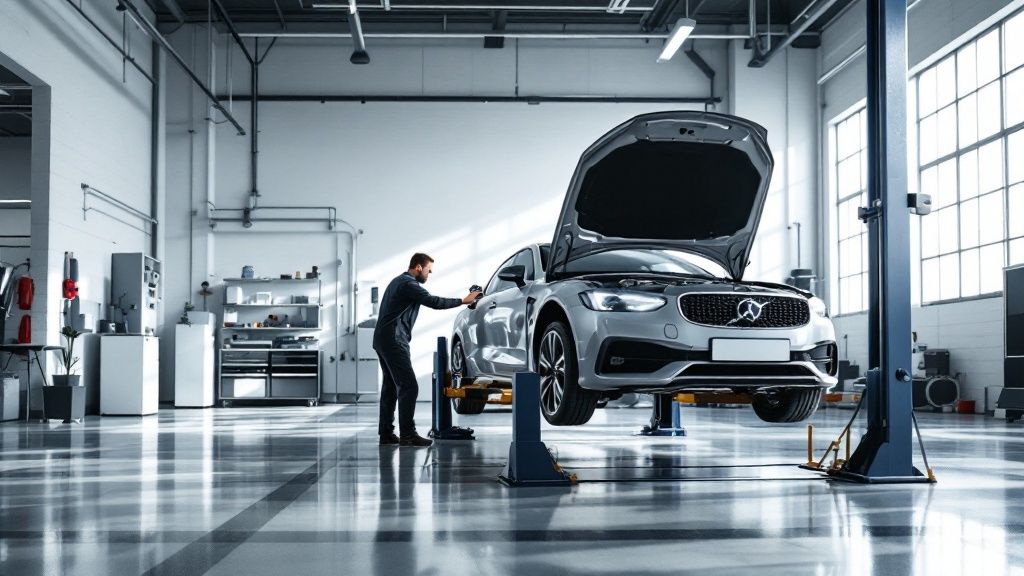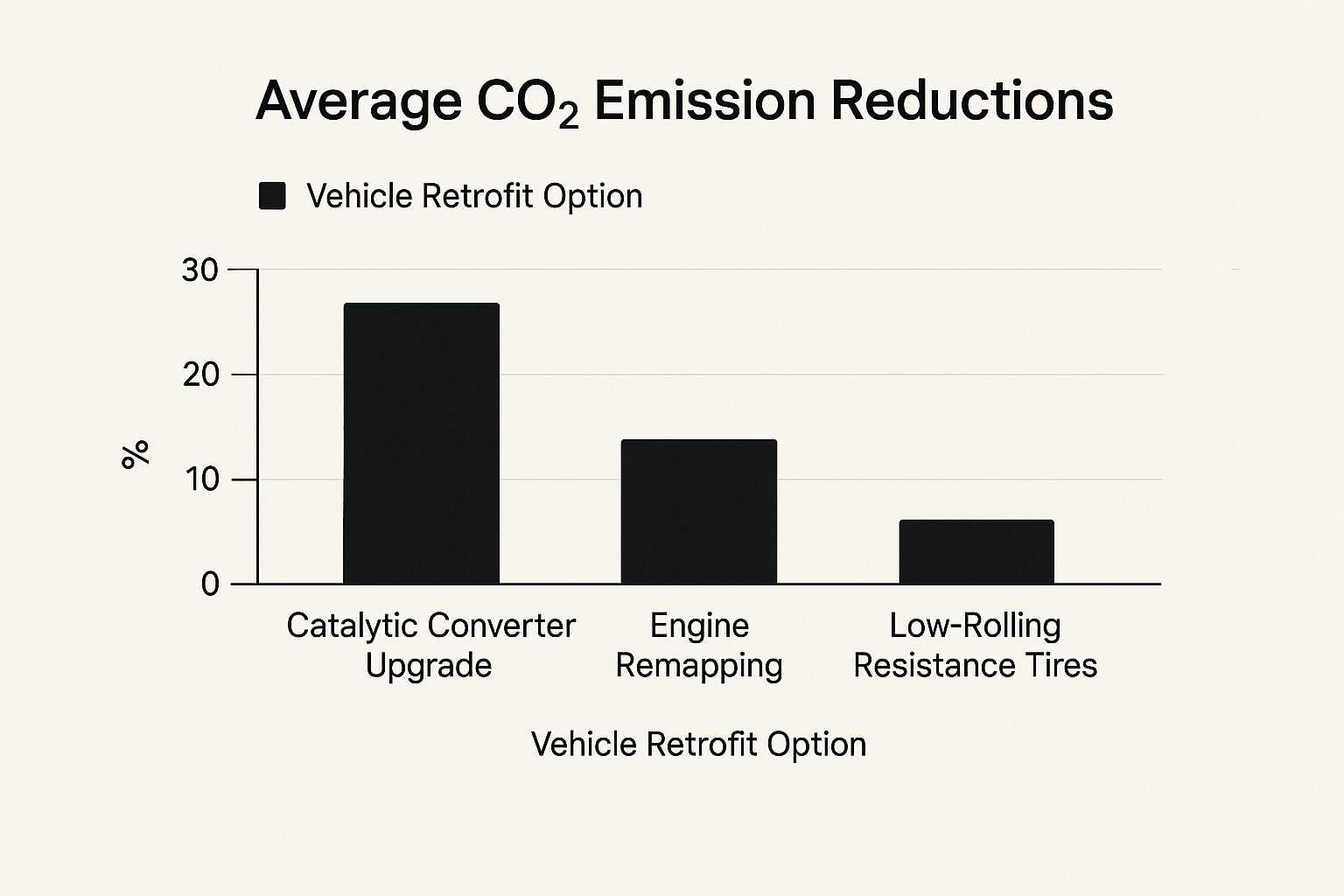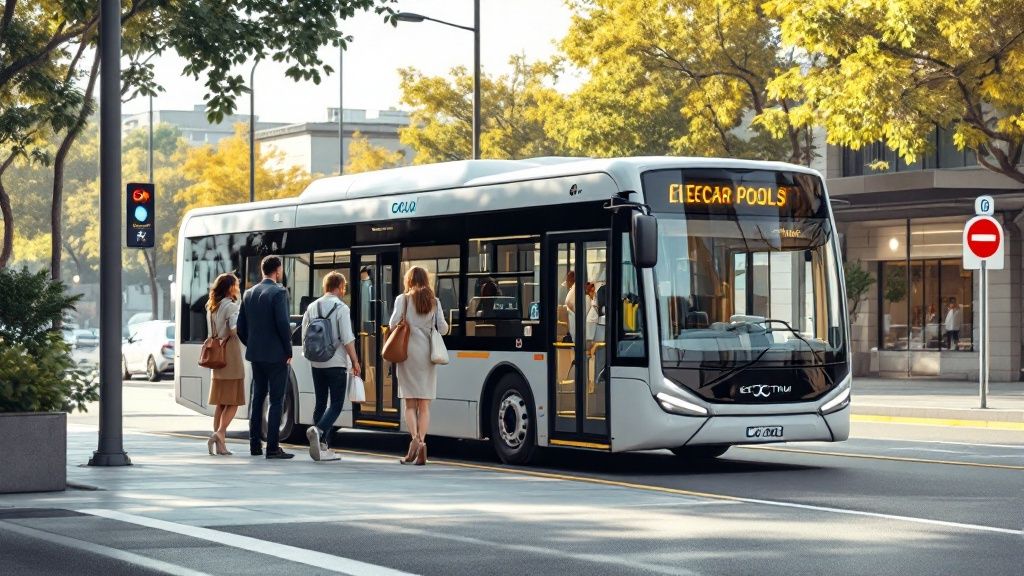It's easier than you might think to reduce your car's emissions. The biggest wins come from a simple formula: drive smoothly, keep your car in good shape, and be smart about your fuel and travel choices.
Things like better driving habits and routine upkeep—even something as basic as checking your tire pressure—can make a huge difference. These small, consistent actions really do add up, significantly cutting down on the pollutants your car releases into the air.
Your Quick Guide to Lowering Vehicle Emissions

Let's get straight to what matters. You're here because you want to understand how your daily commute affects the environment and, more importantly, what you can actually do about it. The great news is you don't have to give up your car. It's about driving smarter.
This guide is all about practical, everyday adjustments that are surprisingly effective. Once you see the connection between your habits and your car's emissions, you're already on the right track to making a real difference.
The Most Impactful Strategies at a Glance
To help you get started, I've put together a quick overview of the most effective ways to lower your vehicle's emissions. Think of it as a cheat sheet for making the biggest impact.
This table breaks down our top recommendations, from simple driving tweaks to bigger decisions about your next vehicle.
| Strategy Category | Key Actions | Impact Level |
|---|---|---|
| Driving Habits | Smooth acceleration, avoiding hard braking, reducing idle time, and using cruise control on highways. | High |
| Vehicle Maintenance | Proper tire inflation, regular oil changes with correct grade, and replacing air filters and spark plugs. | High |
| Fuel & Weight | Using high-quality fuel, removing unnecessary weight from the vehicle, and reducing roof rack use. | Medium |
| Vehicle Choice | Opting for hybrid, plug-in hybrid (PHEV), or battery electric vehicles (BEV) for your next purchase. | Very High |
| Travel Planning | Combining errands into a single trip, choosing alternative transport, or carpooling when possible. | Medium |
Use this as your starting point. You can pick out a few strategies that fit your lifestyle now and maybe plan for others down the road. It’s all about progress, not perfection.
Driving Techniques That Reduce Your Emissions
What if I told you that you could slash your vehicle's emissions without spending a single dollar? It’s true. The secret isn't in some expensive upgrade—it's in how you handle your car on the road. This isn’t about giving up driving. It's about shifting your mindset from just getting there to getting there efficiently.
Aggressive driving habits are a huge problem. Stomping on the gas and slamming on the brakes forces your engine to work overtime, guzzling fuel and spewing out more pollutants. The good news is that by adopting a smoother, more deliberate approach behind the wheel, you can make a serious dent in your car's emissions.
The Art of Smooth and Steady Driving
Start thinking of your car's momentum as a valuable resource you don't want to waste. Instead of just focusing on the bumper in front of you, lift your gaze and look further down the road. Try to anticipate traffic lights and slowdowns.
When you see traffic bunching up ahead, ease off the accelerator and let the car coast. This is so much better than waiting until the last second to brake hard. A gentle touch on the gas pedal is just as crucial. I often tell people to imagine there's an egg under the pedal—your goal is to drive without breaking it.
Key Takeaway: Driving smoothly can boost your fuel mileage by a staggering 30% on the highway and 10-40% in stop-and-go traffic. That's a direct reduction in the harmful emissions coming out of your tailpipe.
For those long highway trips, your cruise control is your best friend. It’s brilliant at maintaining a constant speed, eliminating all the tiny, unconscious speed adjustments we make that burn extra fuel. Just set it and let it help your engine run at its most efficient sweet spot.
Rethink Your Idle Time
Letting your engine idle might seem harmless, but it's the definition of inefficiency. You're getting zero miles per gallon while still pumping out emissions. Here’s a fact that surprises most people: an engine idling for more than 10 seconds burns more fuel than it takes to restart it.
So, if you know you'll be stopped for more than a minute—maybe waiting at a railroad crossing or for a friend to run out of a store—turn the engine off. It’s a simple habit that adds up to a meaningful reduction in your carbon footprint.
Even the most efficient modern engines are wasting fuel when they're running but not moving. This "don't waste energy" principle is core to the design of all efficient vehicles. For instance, a key factor in maximizing an electric golf cart range is minimizing any unnecessary power draw when it's stationary. Applying that same logic to your car just makes sense.
How Smart Maintenance Creates a Cleaner Car

A well-maintained vehicle is a greener vehicle. It's that simple. Think of routine upkeep as a wellness plan for your car—it doesn't just prevent breakdowns, it makes sure the engine is running as cleanly and efficiently as possible. This has a direct impact on reducing your vehicle's emissions.
The best part? Many of these maintenance tasks are easy, inexpensive, and have an immediate effect on both your wallet and your carbon footprint. You don't need to be a professional mechanic to start making a real difference.
The Easiest Wins for Lower Emissions
Some of the most powerful maintenance habits are also the most basic. Let's start with the low-hanging fruit. Properly inflated tires, for example, are probably the single easiest win.
When your tires are underinflated, they create more rolling resistance, which forces the engine to burn more fuel just to keep the car moving. A simple monthly check can boost your gas mileage by up to 3%. That’s a direct cut in emissions from just a few minutes with an air pump.
Using the manufacturer-recommended grade of motor oil is another simple yet powerful tactic. The right oil reduces friction within the engine, allowing it to operate more efficiently and burn fuel more completely, which translates to fewer harmful pollutants escaping through the exhaust.
Ensuring your car is in top shape is especially critical for longer journeys. Many of these essential long-distance driving tips include pre-trip maintenance checks that pay dividends in everyday driving, too.
Key Components for a Clean Burn
Beyond tires and oil, a few small and affordable parts play a huge role in your car's emissions. Neglecting them can lead to poor performance and even a failed emissions test.
A clogged air filter, for instance, is like forcing your engine to breathe through a straw. A clean filter allows the perfect amount of air to mix with fuel, leading to efficient combustion. Swapping it out is a quick job that can immediately improve fuel efficiency.
Here are a few other critical parts to keep on your radar:
- Spark Plugs: These tiny parts ignite the air-fuel mixture. When they get worn out, you get incomplete combustion, which wastes fuel and pumps out more hydrocarbon emissions.
- Oxygen Sensor: This sensor is a sniffer for your exhaust, measuring unburned oxygen. It sends signals to the car's computer to adjust the fuel mixture for peak efficiency. A faulty sensor throws that delicate balance completely out of whack.
While these components are standard for gasoline cars, it’s worth noting the difference if you’re considering an EV. Learning about electric vehicle maintenance shows how switching to electric eliminates many of these emission-related parts entirely. For now, regular check-ups on your gas car are a surefire way to burn fuel as cleanly as possible.
Choosing the Right Low-Emission Vehicle for You
Picking your next car is one of the biggest levers you can pull to shrink your carbon footprint. While your mind might jump straight to a fully electric vehicle (EV), the world of low-emission cars has a lot more to offer. Getting a handle on the real differences between gasoline, hybrid (HEV), plug-in hybrid (PHEV), and battery electric vehicles (BEV) is the first step to finding a car that fits your life and your green goals.
It's about more than just what comes out of the tailpipe. You have to consider the car's entire life story—from the emissions created during manufacturing and battery sourcing to the electricity it uses and how it's recycled at the end of its life.
Thinking Beyond the Tailpipe: Life Cycle Emissions
A car's true environmental cost isn't measured on your daily commute alone. The concept of life cycle emissions gives us the full picture, from the assembly line to the scrapyard. This is where things get really interesting.
For instance, building an EV battery is an energy-heavy process, giving it a bigger carbon "debt" from the start compared to a standard gasoline car. But that initial hit is quickly paid off over the years by the EV’s zero tailpipe emissions.
The real game-changer is where your electricity comes from. An EV sipping power from a coal-fired grid has a much different impact than one charging up on solar or wind. This is why an EV's "clean" credentials are tied directly to how green your local power grid is.
Comparing Your Low-Emission Options
Let's break down the main players on the market. Each has its own strengths and weaknesses, so the "best" choice really comes down to your personal needs.
-
Hybrid Electric Vehicles (HEVs): Think of the classic Toyota Prius. These cars pair a gasoline engine with an electric motor. The battery recharges itself through braking and with help from the engine, so you never have to plug it in. HEVs are a fantastic way to boost fuel efficiency, especially if you do a lot of stop-and-go city driving.
-
Plug-in Hybrid Electric Vehicles (PHEVs): These offer a taste of both worlds. A PHEV has a larger battery that you can charge from an outlet, giving you a solid all-electric range—usually 20-50 miles—that can cover most daily drives. When the battery runs low, the gas engine seamlessly takes over, completely eliminating the range anxiety that can come with going fully electric.
-
Battery Electric Vehicles (BEVs): This is the fully electric experience. With no gas engine at all, BEVs produce zero tailpipe emissions and deliver a quiet, zippy ride. The main things to think about are driving range, access to charging stations, and a higher upfront cost, though you'll save a bundle on fuel and maintenance.
Even if a new car isn't in the cards, you can still make a big difference with your current vehicle. The image below shows how some common retrofits stack up.

As you can see, upgrading your catalytic converter is one of the most powerful changes you can make to an older car.
The Real-World Impact of Going Electric
When you look at the total life cycle, the data is clear: BEVs are the cleanest option by a long shot. A 2023 analysis found that a BEV emits around 63 grams of CO2 equivalent per kilometer. A similar gasoline car? A whopping 250 grams.
That’s a 73% reduction in greenhouse gas emissions over the vehicle's lifetime. It's a massive difference.
Of course, making the switch comes with a bit of a learning curve, especially when it comes to charging. If you're new to the EV world, it helps to understand the basics of how to charge an electric vehicle like a Tesla at home.
Ultimately, the right car is the one that fits your budget, driving habits, and charging situation. For a deeper dive, our comprehensive electric vehicle buying guide can walk you through every consideration. The goal is to find a vehicle that slashes your environmental impact without cramping your lifestyle.
The Bigger Picture: Automakers and Regulations

While your personal driving and maintenance habits are huge levers for change, they're only one part of a much larger story. The companies that build our cars and the governments that regulate them are the real heavyweights shaping the future of transportation. Getting a handle on these forces makes you a smarter consumer and a more effective advocate for clean air.
The auto industry's role is, without a doubt, central to all of this. Every decision a carmaker makes—from the materials they source to the final product's efficiency—creates a ripple effect. This goes way beyond what comes out of the tailpipe; it’s about the entire journey from raw material to rolling vehicle.
The Automaker's Role in Building Greener Cars
A truly low-emission vehicle begins its life long before you see it in a showroom. The manufacturing process itself has a hefty carbon footprint, and automakers are finally feeling the heat to clean up their acts from start to finish.
This means putting every single component under the microscope. Take the steel and aluminum that make up a car's body—producing it is incredibly energy-intensive. The more forward-thinking companies are now actively seeking out "green steel" made with renewable energy, which slashes the car's built-in carbon debt right from the get-go.
That same level of scrutiny is being applied to the heart of every electric vehicle: the battery.
- Sourcing Sustainably: Mining for lithium, cobalt, and other key materials can be destructive. Responsible automakers are pushing for better extraction methods and, just as importantly, building robust recycling programs to recover these precious resources.
- Cleaner Production: Making batteries is another energy-hungry process. The big move here is shifting to factories powered by solar, wind, and other renewables to shrink an EV's lifetime emissions profile.
The automotive sector is responsible for over 20% of global greenhouse gas emissions, a staggering figure that highlights its massive influence. Big players like Ford, Toyota, and Volkswagen have a huge part to play in steering their operations toward climate goals. But as a 2025 automotive sector report points out, progress on things like sourcing near-zero-emission steel and cleaning up battery production is still pretty patchy across the board.
How Government Rules Force Innovation
Let's be honest: without firm government policies and emissions standards, the move to cleaner cars would be happening at a snail's pace. Regulations are the real engine of change, creating a level playing field and forcing every manufacturer to invest in cleaner technology.
Key Insight: Policies like the Corporate Average Fuel Economy (CAFE) standards in the U.S. or the Euro emissions standards in Europe set non-negotiable targets for pollution. These rules are directly responsible for pushing automakers to design more efficient engines, develop hybrid systems, and speed up their transition to fully electric lineups.
These standards don't just dictate what's under the hood. They also spur innovation in aerodynamics, the use of lightweight materials, and the development of low-rolling-resistance tires—all pieces of the puzzle that help cut emissions.
For you, the driver, these regulations mean you have access to cleaner and more efficient cars than ever before. Understanding these policies empowers you to demand even stronger standards and hold everyone accountable for a cleaner automotive future.
Common Questions About Reducing Vehicle Emissions
As you start looking for ways to shrink your car's carbon footprint, a few questions always seem to come up. It's totally normal. We're trying to separate fact from fiction and figure out what actually works in the real world.
This section tackles those common questions head-on. We'll get into whether small tweaks matter, what to do if you're not ready for an EV, and more. The idea is to give you the confidence to start making smart, effective changes today.
Will My Old Car Ever Be Clean Enough?
This is a big one. Lots of people assume you need to buy a brand-new electric car to make a difference. The truth is, while new cars are cleaner, a well-maintained older car can be surprisingly eco-friendly. It all comes down to diligence.
Simple things like swapping out your air filter on schedule, keeping tires at the right pressure, and making sure your spark plugs are fresh can slash the pollutants your car emits. These aren't huge, expensive jobs, but they add up to a vehicle that runs cleaner and more efficiently.
The Bottom Line: Don't write off your current car. A well-cared-for older vehicle is far better for the environment than a neglected one. Smart maintenance is your most powerful tool.
How Much Difference Do Driving Habits Really Make?
More than you might think. Changing how you drive is one of the fastest, most effective ways to cut emissions, and it doesn't cost a dime.
Think about it: aggressive driving—slamming the gas, braking hard at the last second—forces your engine to work overtime. This can spike your fuel consumption by up to 40% in city driving, and more fuel burned means more emissions.
By driving smoothly—looking ahead to anticipate stops, coasting to red lights, and keeping a steady pace on the highway—you put less strain on the engine. It's a simple mental shift that not only lowers your emissions but also saves a surprising amount of cash on gas and reduces wear on your brakes and tires.
Are Electric Cars Truly a Zero-Emission Solution?
This gets a little more complex. While it's true that battery electric vehicles (BEVs) have no tailpipe emissions, calling them "zero-emission" isn't the whole story.
The manufacturing process, especially for the battery, requires a lot of energy. And, of course, the electricity used to charge the car has to come from somewhere—and our power grid still relies heavily on fossil fuels in many places.
Even with all that considered, the total life-cycle emissions of an EV are still significantly lower than a comparable gas-powered car. As our electrical grid gets cleaner and incorporates more renewables, the environmental edge for EVs will just get bigger.
How Are Regulations Pushing for Cleaner Cars?
Government rules are a huge driver of change in the auto industry. Take the European Union, for example. They have incredibly strict CO2 emissions targets for 2025 that are forcing carmakers to go electric, fast.
BMW is aiming for 25% of its sales to be fully electric by 2025, a move that should lead to a 48% CO2 reduction for those vehicles. As detailed in the full research about these 2025 targets, car companies face billions in penalties if they miss these goals. These regulations are a big reason why you’re seeing so many more clean vehicle options on the market.
Ready to explore the future of clean, stylish, and powerful transportation? Solana EV offers a premium lineup of street-legal electric vehicles designed for any adventure, from community cruising to off-road exploration. Discover our innovative models and find the perfect ride for your lifestyle at https://solanaev.com.
